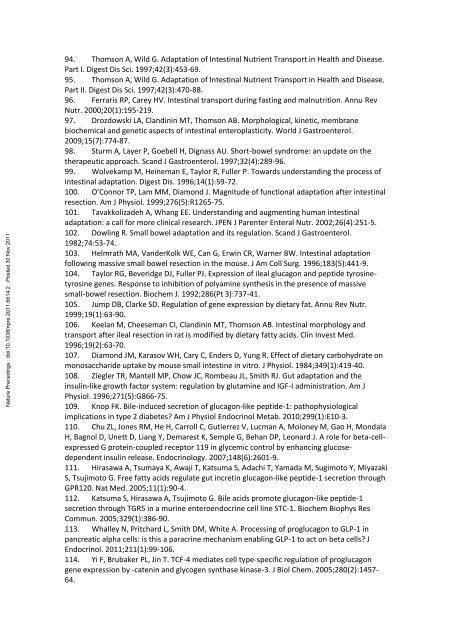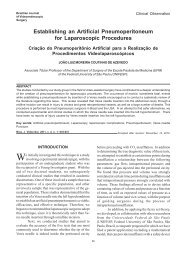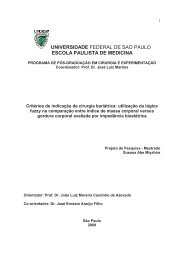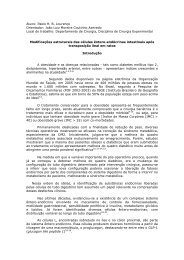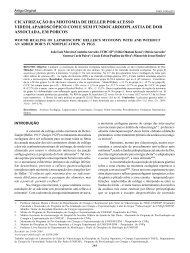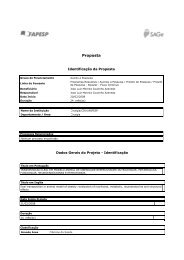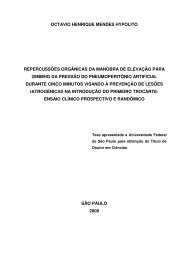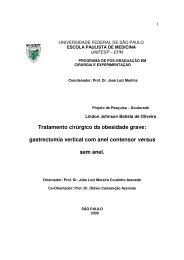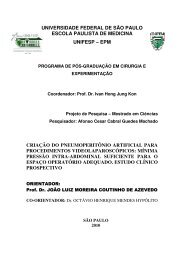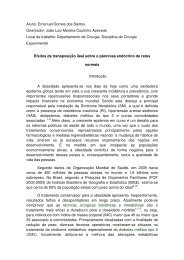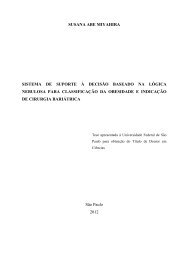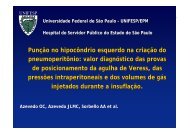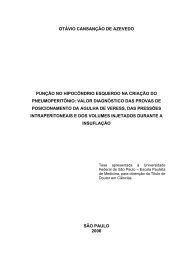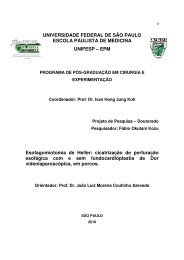Isolated ileal interposition in enteroendocrine L cells differentiation
Isolated ileal interposition in enteroendocrine L cells differentiation
Isolated ileal interposition in enteroendocrine L cells differentiation
You also want an ePaper? Increase the reach of your titles
YUMPU automatically turns print PDFs into web optimized ePapers that Google loves.
Nature Preced<strong>in</strong>gs : doi:10.1038/npre.2011.6614.2 : Posted 30 Nov 2011<br />
94. Thomson A, Wild G. Adaptation of Intest<strong>in</strong>al Nutrient Transport <strong>in</strong> Health and Disease.<br />
Part I. Digest Dis Sci. 1997;42(3):453-69.<br />
95. Thomson A, Wild G. Adaptation of Intest<strong>in</strong>al Nutrient Transport <strong>in</strong> Health and Disease.<br />
Part II. Digest Dis Sci. 1997;42(3):470-88.<br />
96. Ferraris RP, Carey HV. Intest<strong>in</strong>al transport dur<strong>in</strong>g fast<strong>in</strong>g and malnutrition. Annu Rev<br />
Nutr. 2000;20(1):195-219.<br />
97. Drozdowski LA, Cland<strong>in</strong><strong>in</strong> MT, Thomson AB. Morphological, k<strong>in</strong>etic, membrane<br />
biochemical and genetic aspects of <strong>in</strong>test<strong>in</strong>al enteroplasticity. World J Gastroenterol.<br />
2009;15(7):774-87.<br />
98. Sturm A, Layer P, Goebell H, Dignass AU. Short-bowel syndrome: an update on the<br />
therapeutic approach. Scand J Gastroenterol. 1997;32(4):289-96.<br />
99. Wolvekamp M, He<strong>in</strong>eman E, Taylor R, Fuller P. Towards understand<strong>in</strong>g the process of<br />
<strong>in</strong>test<strong>in</strong>al adaptation. Digest Dis. 1996;14(1):59-72.<br />
100. O’Connor TP, Lam MM, Diamond J. Magnitude of functional adaptation after <strong>in</strong>test<strong>in</strong>al<br />
resection. Am J Physiol. 1999;276(5):R1265-75.<br />
101. Tavakkolizadeh A, Whang EE. Understand<strong>in</strong>g and augment<strong>in</strong>g human <strong>in</strong>test<strong>in</strong>al<br />
adaptation: a call for more cl<strong>in</strong>ical research. JPEN J Parenter Enteral Nutr. 2002;26(4):251-5.<br />
102. Dowl<strong>in</strong>g R. Small bowel adaptation and its regulation. Scand J Gastroenterol.<br />
1982;74:53-74.<br />
103. Helmrath MA, VanderKolk WE, Can G, Erw<strong>in</strong> CR, Warner BW. Intest<strong>in</strong>al adaptation<br />
follow<strong>in</strong>g massive small bowel resection <strong>in</strong> the mouse. J Am Coll Surg. 1996;183(5):441-9.<br />
104. Taylor RG, Beveridge DJ, Fuller PJ. Expression of <strong>ileal</strong> glucagon and peptide tyros<strong>in</strong>etyros<strong>in</strong>e<br />
genes. Response to <strong>in</strong>hibition of polyam<strong>in</strong>e synthesis <strong>in</strong> the presence of massive<br />
small-bowel resection. Biochem J. 1992;286(Pt 3):737-41.<br />
105. Jump DB, Clarke SD. Regulation of gene expression by dietary fat. Annu Rev Nutr.<br />
1999;19(1):63-90.<br />
106. Keelan M, Cheeseman CI, Cland<strong>in</strong><strong>in</strong> MT, Thomson AB. Intest<strong>in</strong>al morphology and<br />
transport after <strong>ileal</strong> resection <strong>in</strong> rat is modified by dietary fatty acids. Cl<strong>in</strong> Invest Med.<br />
1996;19(2):63-70.<br />
107. Diamond JM, Karasov WH, Cary C, Enders D, Yung R. Effect of dietary carbohydrate on<br />
monosaccharide uptake by mouse small <strong>in</strong>test<strong>in</strong>e <strong>in</strong> vitro. J Physiol. 1984;349(1):419-40.<br />
108. Ziegler TR, Mantell MP, Chow JC, Rombeau JL, Smith RJ. Gut adaptation and the<br />
<strong>in</strong>sul<strong>in</strong>-like growth factor system: regulation by glutam<strong>in</strong>e and IGF-I adm<strong>in</strong>istration. Am J<br />
Physiol. 1996;271(5):G866-75.<br />
109. Knop FK. Bile-<strong>in</strong>duced secretion of glucagon-like peptide-1: pathophysiological<br />
implications <strong>in</strong> type 2 diabetes? Am J Physiol Endocr<strong>in</strong>ol Metab. 2010;299(1):E10-3.<br />
110. Chu ZL, Jones RM, He H, Carroll C, Gutierrez V, Lucman A, Moloney M, Gao H, Mondala<br />
H, Bagnol D, Unett D, Liang Y, Demarest K, Semple G, Behan DP, Leonard J. A role for beta-cellexpressed<br />
G prote<strong>in</strong>-coupled receptor 119 <strong>in</strong> glycemic control by enhanc<strong>in</strong>g glucosedependent<br />
<strong>in</strong>sul<strong>in</strong> release. Endocr<strong>in</strong>ology. 2007;148(6):2601-9.<br />
111. Hirasawa A, Tsumaya K, Awaji T, Katsuma S, Adachi T, Yamada M, Sugimoto Y, Miyazaki<br />
S, Tsujimoto G. Free fatty acids regulate gut <strong>in</strong>cret<strong>in</strong> glucagon-like peptide-1 secretion through<br />
GPR120. Nat Med. 2005;11(1):90-4.<br />
112. Katsuma S, Hirasawa A, Tsujimoto G. Bile acids promote glucagon-like peptide-1<br />
secretion through TGR5 <strong>in</strong> a mur<strong>in</strong>e enteroendocr<strong>in</strong>e cell l<strong>in</strong>e STC-1. Biochem Biophys Res<br />
Commun. 2005;329(1):386-90.<br />
113. Whalley N, Pritchard L, Smith DM, White A. Process<strong>in</strong>g of proglucagon to GLP-1 <strong>in</strong><br />
pancreatic alpha <strong>cells</strong>: is this a paracr<strong>in</strong>e mechanism enabl<strong>in</strong>g GLP-1 to act on beta <strong>cells</strong>? J<br />
Endocr<strong>in</strong>ol. 2011;211(1):99-106.<br />
114. Yi F, Brubaker PL, J<strong>in</strong> T. TCF-4 mediates cell type-specific regulation of proglucagon<br />
gene expression by -caten<strong>in</strong> and glycogen synthase k<strong>in</strong>ase-3. J Biol Chem. 2005;280(2):1457-<br />
64.


